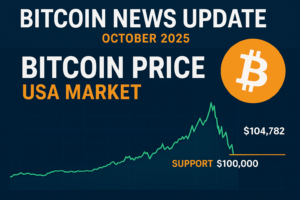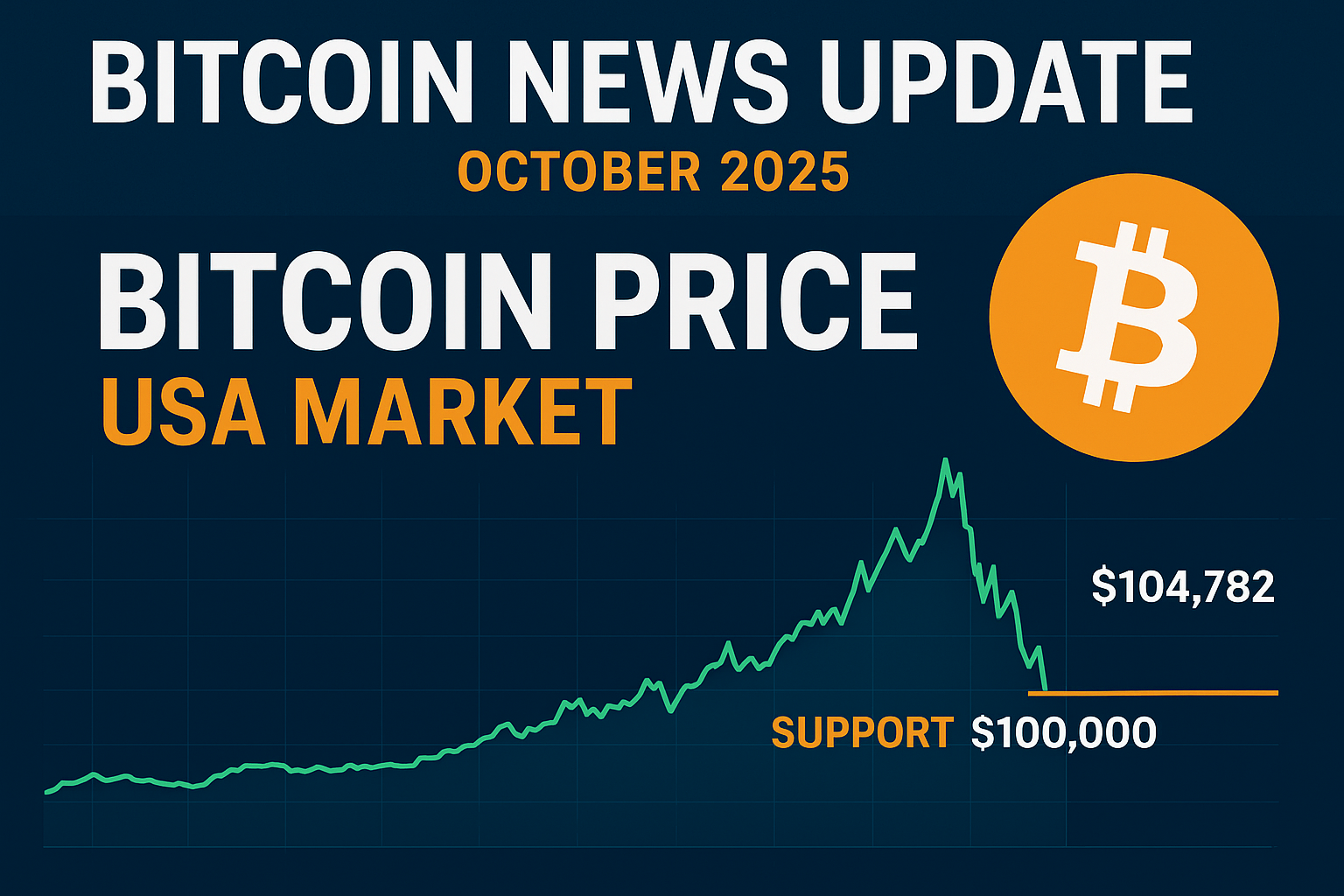Bitcoin Price & News USA 2025
Contents
- 1 Bitcoin Price & News USA 2025 – Latest Updates, Trends & Outlook
- 2 Introduction
- 3 1. Recent Price Action: USA Market Focus
- 4 2. Key Drivers in the USA Market
- 5 3. Technical Levels & Market Structure
- 6 4. U.S. Market Sentiment & Risks
- 7 5. What to Watch Next (U.S.-Focused)
- 8 6. Conclusion
- 9 FAQs (Frequently Asked Questions)
Bitcoin Price & News USA 2025 – Latest Updates, Trends & Outlook
Meta Description:
Get the latest Bitcoin news and price updates in the USA (2025). Analysis of ETF flows, U.S. regulation, technical levels, market sentiment, and what’s ahead.
Target Keywords / Phrases (USA-focus):
- Bitcoin price USA
- Bitcoin news USA
- BTC news USA
- Bitcoin market update USA
- Bitcoin ETF USA
- US crypto regulation 2025
Tags / SEO Tags (for blog post):
Bitcoin, USA, Bitcoin News, BTC, Crypto, Bitcoin Price USA, US Regulation, ETF, Crypto Market, 2025 Outlook

Introduction
Bitcoin continues to dominate headlines worldwide, but in 2025, the USA crypto market is especially pivotal. With renewed institutional involvement, regulatory shifts, and macroeconomic volatility, the U.S. has become central to Bitcoin’s next leg. In this article, we bring you live Bitcoin price updates for the USA, analyze key drivers, and present an outlook grounded in both technicals and fundamentals.
As of early October 2025, Bitcoin has been on a wild ride—soaring to fresh highs, then sharply retracting following geopolitical shocks. This volatility underscores just how entwined crypto markets now are with U.S. policy, institutional flows, and economic sentiment.
In this detailed report, you’ll find:
- The latest price moves in the U.S.
- Influence of ETFs and institutional demand
- U.S. regulatory developments
- Technical support & resistance levels
- Market sentiment and risk factors
- FAQs
- A strong conclusion summarizing what to watch
Let’s dive in.
1. Recent Price Action: USA Market Focus
1.1 All-time highs fueled by ETF flows
In early October 2025, Bitcoin surged to a new all-time high above $125,000. (Tom’s Hardware) This rally was driven by increasing investor confidence in U.S. equities, strong inflows into Bitcoin ETFs, and renewed demand from institutions. (The Economic Times)
However, after reaching that peak near ~$125–126K, the price has pulled back significantly. (Reuters)
1.2 The sharp correction: trade war shock
On October 10, 2025, Bitcoin extended its decline by 8.4% to $104,782 following U.S. President Donald Trump’s decision to impose 100% tariffs on Chinese tech exports and tighter export controls on “critical software.” (Reuters) This move sent shockwaves through global and crypto markets, triggering mass liquidations and panic selling. (The Economic Times)
The result: over $19 billion wiped out across the crypto market in one session. (The Economic Times)
This illustrates how dependent Bitcoin has become on macro and geopolitical factors—especially in U.S.–China dynamics.
1.3 Recent stabilization & current levels
Following the sharp dip, Bitcoin attempted to stabilize in the $110,000–$120,000 range. Some reports indicate price pressures pushing it closer to $118,000 territory after fresh trade tension news. (Bitcoin Magazine)
Nonetheless, volatility remains high, and the market is reacting swiftly to every major headline out of Washington or Beijing.
2. Key Drivers in the USA Market
2.1 Institutional flows & ETF demand
One of the most critical narratives in 2025 is the rising role of Bitcoin ETFs in the U.S. These products allow institutions and retail investors to gain exposure to BTC without holding the coin directly.
The recent rally toward $125,000 was strongly supported by these inflows. (The Economic Times) Bitcoin “rode ETF inflows” to hit that record high. (The Economic Times)
Large asset managers and pension funds are now more comfortable investing in regulated vehicles, pushing more capital into the crypto space.
2.2 U.S. regulation & government moves
The regulatory environment in the U.S. is evolving. One notable development: President Trump’s executive order to establish a Strategic Bitcoin Reserve, whereby the U.S. government will hold seized BTC and not sell it. (AP News) This is a symbolic and structural shift, positioning Bitcoin more centrally in national strategy.
This reserve move may bolster confidence among long-term investors, signaling that BTC is being taken seriously by state actors. (Wikipedia)
Additionally, the political winds in the U.S. remain volatile. Any sweeping regulatory or tax proposals—especially around capital gains or crypto classification—could trigger significant price reactions.
2.3 Macroe & geopolitical influence
Bitcoin in 2025 is rarely isolated from macro forces. The U.S.–China trade war escalation is a clear example. Trump’s tariff move caused immediate and severe crypto market stress. (Reuters)
Meanwhile, global monetary policy, inflation figures, and U.S. Federal Reserve decisions are constantly affecting investor risk appetite. As the U.S. dollar experiences pressure, Bitcoin is increasingly seen as a hedge or alternative.
2.4 On-chain supply & accumulation
Though U.S.-centered in focus, Bitcoin’s on-chain metrics influence price. In recent months, a substantial portion of BTC has been transferred into long-term storage, reducing liquid supply. (Tom’s Hardware) Also, many large holders are accumulating rather than distributing at these new highs. (Aurpay)
In short: supply is tightening while demand (especially via ETFs) remains strong.
3. Technical Levels & Market Structure
3.1 Support zones to watch (USA market)
Key support levels (for U.S. trading sentiment) include:
- $100,000 – $110,000: major support zone—the zone to hold to prevent further breakdown
- $110,000 – $115,000: intermediate buffer (if support is lost below)
- $118,000 – $122,000: range where price is attempting consolidation
If Bitcoin loses the $100K–$110K support band, the risk of deeper correction increases.
3.2 Resistance & upside targets
On the upside, analysts are focusing on:
- $125,000: immediate resistance (psychological and recent peak)
- $130,000 – $135,000: next target zone
- $140,000+: ambitious upside if momentum returns strongly
Some models project $135,000–$145,000 by end of Q4 2025, assuming continued ETF inflows and no major macro shocks (these are aggressive but not impossible). (Aurpay)
3.3 Chart momentum & indicators (U.S. context)
While specific charts differ by exchange, general signs support the bullish case:
- RSI and momentum indicators show strength, not extreme overbought yet
- Bitcoin is above key moving averages on daily/weekly charts
- Breakouts and re-tests are shaping a base of support around prior resistance zones
However, shorter-term oscillators (e.g. MACD) may signal overextension in smaller timeframes, so pullbacks are plausible.
4. U.S. Market Sentiment & Risks
4.1 Sentiment: fear and greed swinging
The mood in the U.S. crypto market is oscillating sharply. The highs near $125K brought excitement, but the sudden crash reminds participants of the inherent volatility. Many traders are now more cautious, reducing leverage and watching headlines closely.
Some narrative drivers:
- “Bitcoin as digital gold / inflation hedge”
- Institutional “legitimacy” via ETFs
- Regulatory risk: any negative policies in the U.S. can trigger steep reactions
- Macro risk: interest rate missteps, policy shocks, or trade wars
4.2 Major risk factors
Key risks to watch in the U.S. context:
| Risk | Implication |
|---|---|
| Loss of key support ($100K–$110K) | Could trigger broader sell-off |
| Adverse U.S. regulation or tax announcement | Could scare institutional capital |
| Macroe “black swan” event | Sudden risk-off mode, capital flows out |
| Profit-taking at psychological levels | Resistance zones might act as ceilings |
| Overreliance on ETF flows | If inflows slow, momentum may reverse |
Because of these, Bitcoin’s path forward is far from guaranteed—even if the long-term trend looks bullish.
5. What to Watch Next (U.S.-Focused)
To gauge the near-term direction, these catalysts will be critical:
- ETF Inflows / AUM Reports
How much capital continues to flow into Bitcoin ETFs matters. Sustained inflows suggest institutional conviction. - U.S. Economic Data
Inflation, job numbers, GDP, and Fed statements will shift sentiment. A hawkish move could spook markets. - Trade / Geopolitical Developments
Any escalation in U.S.–China tensions or new tariffs may produce volatility. - Regulatory Announcements or Legislation
Anything from SEC rulings to tax proposals affecting crypto can swing price sharply. - On-Chain Metrics
Exchange outflows, accumulation rates, and large whale moves will hint at the underlying demand. - Market Depth & Liquidity
Watching order book depth on key U.S. exchanges helps assess how robust support or resistance zones are.
6. Conclusion
Bitcoin’s journey in 2025 is being shaped heavily by the U.S. market. The push past $125,000 was historic and built on strong ETF flows and institutional interest. But the sudden 8.4% crash following new tariffs illustrates how fragile that rally was in the face of macro shocks.
Going forward, the U.S. market will play a leading role in determining Bitcoin’s direction. If support zones around $100K–$110K hold and inflows continue, a return to $130K+ is plausible. On the other hand, breakdowns or negative regulatory developments in the U.S. could send BTC sliding.
For U.S.-based investors and watchers, the interplay between regulation, macro policy, and institutional capital is now inseparable from crypto price action. Stay alert to headlines from Washington, ETF flow reports, and macro data—these may decide whether Bitcoin can sustain a new bull cycle or falter under volatility.
FAQs (Frequently Asked Questions)
Q1: What is the current Bitcoin price in the USA?
A1: As of the latest reports in October 2025, Bitcoin fell to around $104,782 following the U.S.-China trade escalation. (Reuters) It has attempted to recover into the $110K–$120K zone.
Q2: Why did Bitcoin crash so sharply recently?
A2: The crash was triggered by unexpected geopolitical news—U.S. President Trump’s imposition of 100% tariffs on Chinese tech exports and export controls on software. (Reuters) This caused panic across crypto markets and large liquidations (over $19B). (The Economic Times)
Q3: How important is ETF flow to Bitcoin’s U.S. price?
A3: Very important. ETF inflows provide regulated, institutional-level demand. They reduce friction for big capital moving into crypto, and much of 2025’s rally is attributed to strong ETF interest in the U.S. (The Economic Times)
Q4: What support level should U.S. investors watch?
A4: The most critical support range is $100,000 to $110,000. If Bitcoin breaks decisively below this zone, a deeper correction becomes likely.
Q5: Can regulation in the U.S. affect Bitcoin price?
A5: Absolutely. U.S. regulatory policy—on taxation, securities classification, crypto oversight—can influence institutional confidence, capital flow, and overall sentiment. Any adverse move may provoke withdrawals or price dips.
Do you want me to send those too?

![Crypto Security & Hacks Trends [2025 USA]](https://charmednames.com/wp-content/uploads/2025/10/ChatGPT-Image-Oct-12-2025-05_29_50-PM-768x512.png)